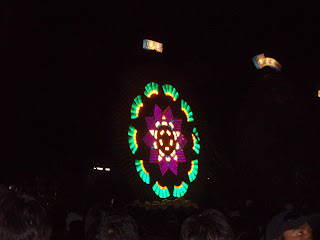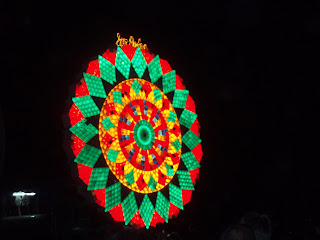
Saturday, December 20, 2008
Giant Lantern Festival

Friday, December 19, 2008
Update Your Home for the Holiday Season
Get Your Home Ready to Shine and Sparkle with New Paint Colors
From About.com
Crisp nights and shorter days are signals of the approaching holiday season. In preparation for seasonal entertaining, now is a great time to freshen up your living space with simple and easy painting ideas.
Debbie Zimmer, of the Rohm and Haas Paint Quality Institute, offers suggestions on how to create a festive atmosphere for each room of your home.
Find more information and innovative ways to use paint and decorating and color trends from the web site of the Paint Quality Institute at www.paintquality.com
Sunday, December 14, 2008
Holidays & Seasons
From About.com
Make holidays and special occasions memorable with unique decorations and home decor. Transform your home for the seasons, too.
decorations. They include:
- Your Home's Color Scheme - Focus on the colors you have in your home year 'round and select complimentary colors that bring out the seasonal feeling. Here are more ways you can find colors for a Christmas color scheme.
- Colors from Your Childhood Christmases - If you have particularly happy memories from Christmas past, try to choose a color theme to enhance that memory. If you loved all the candy canes, choose a red and white color scheme. Did your tree have shiny silver tinsel laid over the boughs? Maybe you'd like a silver glittery color scheme. How about the bubble lights from the 50's and 60's? Choose a color scheme that brings all those colors to mind.
- Colors from a Decorating Motif - Do you love the luscious and luminous beaded fruits? Then you might want to bring the jewel tones into all you Christmas decorating. Do you love rustic, earthy decorations? Then you might want to stick with greens, browns, and golds.
- A Piece of Fabric - If you have seen a beautiful fabric that would be spectacular on the center of your dining room table, draw your Christmas colors from the fabric design. Bring the hues into all the rooms for a unified look.
- A Sentimental Collectible Christmas Decoration - Were you given a special Christmas decoration from your childhood home? If so, make that the focal point and use the colors from it for your color scheme. I was given a porcelain lighted Christmas tree that we had for years on the table in our entry hall. It's easy to decorate around, of course, but it always has a place of importance.
- Hues from Your Home - If your home has warm colors, it would be best to choose golds and reds for decorations rather than icy white and silver. Keep with the feeling of your home for a harmonious decor.
- Photos from Magazines and Books - Though the pictures might look casual and lived in, most photo layouts from magazines and books are "staged" by professional designers. Use their ideas to bring the color scheme and designs into your home.
- Holiday Gift Wrap - You can see lots of color schemes used in Christmas gift wrapping paper. See which ones you like and think about the style, the motifs represented, and the colors. Choose a paper that would look good in your home and find more decorations to place around the house.
- Ribbons - Almost any Christmas decorating is enhanced by adding ribbons and bows, lots of them. If you find a ribbon that you particularly like, use the colors for the decorating scheme throughout your home.
When decorating a room, there are many things to think about. Space planning, flooring, lighting, furniture, and window treatments are just a few. You'll find interesting information here about how to incorporate all of the elements of décor into your decorating project and use them to the best advantage for your space.
Accessories and Accents (161) Furniture (573) Art in Decorating (41) Interior Lighting (184) Color in Decor (80) Luxury Home Products (62) Decorative Moldings (39) Using Flowers in Decorating (73) Fabrics In Decorating (41) Walls and Ceilings (418) Fireplaces (31) Window Treatments (112) Flooring (179)
Finishing Touches Perk Up a Room If you've been decorating a room but just don't think it's done, you probably need to add some finishing touches. Our tips on adding finishing touches to your decorating project might just be the answer to "What have I forgotten?"
House generally refers to a shelter or building that is a dwelling or place for habitation by human beings. The term includes many kinds of dwellings ranging from rudimentary huts of nomadic tribes to high-rise apartment buildings.[1] However, the word can also be used as a verb ("to house"), and can have adjectival formations as well. In some contexts, "house" may mean the same as dwelling, residence, home, abode, accommodation, housing, lodging, among other meanings. The social unit that lives in a house is known as a household. Most commonly, a household is a family unit of some kind, though households can be other social groups, such as single persons, or groups of unrelated individuals. Settled agrarian and industrial societies are composed of household units living permanently in housing of various types, according to a variety of forms of land tenure. English-speaking people generally call any building they routinely occupy "home". Many people leave their houses during the day for work and recreation but typically return to them to sleep or for other activities.
Structure
The developed world in general features three basic types of house that have their own ground-level entry and private open space, and usually on a separately titled parcel of land:
Single-family detached houses - free-standing on all sides.
Semi-detached houses (duplexes) - houses that are attached, usually to only one other house via a party wall.
Terraced house (UK) also known as a row house or townhouse - attached to other houses, possibly in a row, each separated by a party wall.
In addition, there are various forms of attached housing where a number of dwelling units are co-located within the same structure, which share a ground-level entry and may or may not have any private open space, such as apartments (a.k.a. flats) of various scales. Another type of housing is movable, such as houseboats, caravans, and trailer homes.
In the United Kingdom, 27% of the population live in terraced houses and 32% in semi-detached houses, as of 2002. In the United States as of 2000, 61.4% of people live in detached houses and 5.6% in semi-detached houses, 26% in row houses or apartments, and 7% in mobile homes.
ShapeArchaeologists have a particular interest in house shape: they see the transition over time from round huts to rectangular houses as a significant advance in optimizing the use of space, and associate it with the growth of the idea of a personal area (see personal space).FunctionA Nalukettu traditional Kerala house in IndiaSome houses transcend the basic functionality of providing "a roof over one's head" or of serving as a family "hearth and home". When a house becomes a display-case for wealth and/or fashion and/or conspicuous consumption, we may speak of a "great house". The residence of a feudal lord or of a ruler may require defensive structures and thus turn into a fort or a castle. The house of a monarch may come to house courtiers and officers as well as the royal family: this sort of house may become a palace. Moreover, in time the lord or monarch may wish to retreat to a more personal or simple space such as a villa, a hunting lodge or a dacha. Compare the popularity of the holiday house or cottage, also known as a crib.In contrast to a relatively upper class or modern trend to ownership of multiple houses, much of human history shows the importance of multi-purpose houses. Thus the house long served as the traditional place of work (the original cottage industry site or "in-house" small-scale manufacturing workshop) or of commerce (featuring, for example, a ground floor "shop-front" shop or counter or office, with living space above). During the Industrial Revolution there was a separation of manufacturing and banking from the house, though to this day some shopkeepers continue (or have returned) to live "over the shop".
Inside the house
Layout
Ideally, architects of houses design rooms to meet the needs of the people who will live in the house. Such designing, known as "interior design", has become a popular subject in universities. Feng shui, originally a Chinese method of situating houses according to such factors as sunlight and micro-climates, has recently expanded its scope to address the design of interior spaces with a view to promoting harmonious effects on the people living inside the house. Feng shui can also mean the 'aura' in or around a dwelling. Compare the real-estate sales concept of "indoor-outdoor flow".
The square footage of a house in the United States reports the area of "living space", excluding the garage and other non-living spaces. The "square meters" figure of a house in Europe reports the area of the walls enclosing the home, and thus includes any attached garage and non-living spaces
Parts
Many houses have several rooms with specialized functions. These may include a living/eating area, a sleeping area, and (if suitable facilities and services exist) washing and lavatory areas. In traditional agriculture-oriented societies, domestic animals such as chickens or larger livestock (like cattle) often share part of the house with human beings. Most conventional modern houses will at least contain a bedroom, bathroom, kitchen (or kitchen area), and a living room. A typical "foursquare house" (as pictured) occurred commonly in the early history of the United States of America, with a staircase in the center of the house, surrounded by four rooms, and connected to other sections of the house (including in more recent eras a garage).
The names of parts of a house often echo the names of parts of other buildings, but could typically include:
atrium
attic
alcove
basement / cellar
bathroom (in various senses of the word)
bath / shower
toilet
bedroom (or nursery, for infants or small children)
conservatory
dining room
family room or den
Fireplace (for warmth during winter; generally not found in warmer climates)
foyer
front room (in various senses of the phrase)
garage
hallway/passage
hearth - often an important symbolic focus of family togetherness
kitchen
larder
laundry room
library
living room
loft
lounge
nook
office or study
pantry
parlour
recreation room / rumpus room / television room
shrines to serve the religious functions associated with a family
stairwell
sunroom
storage room / box room
workshop






















